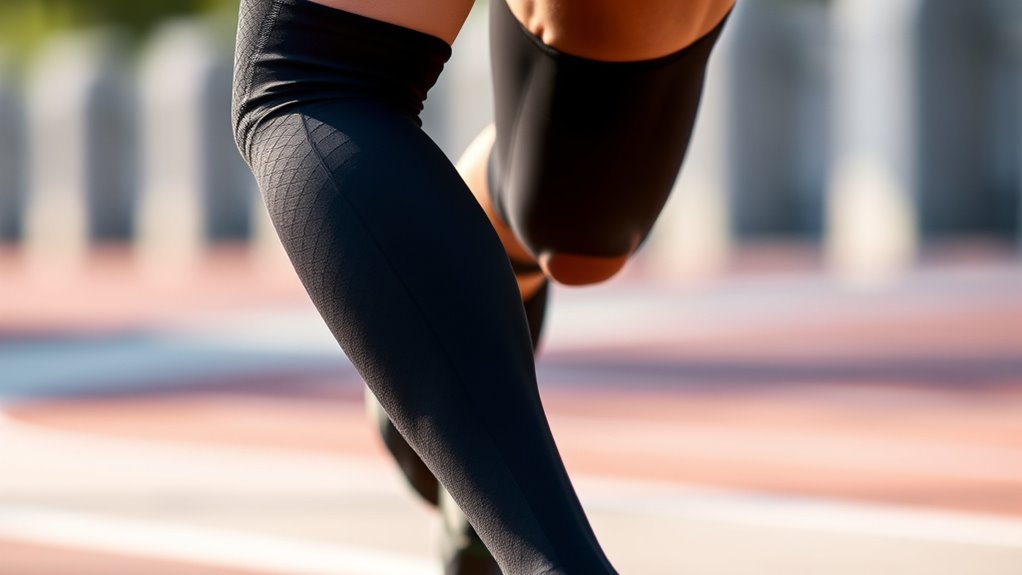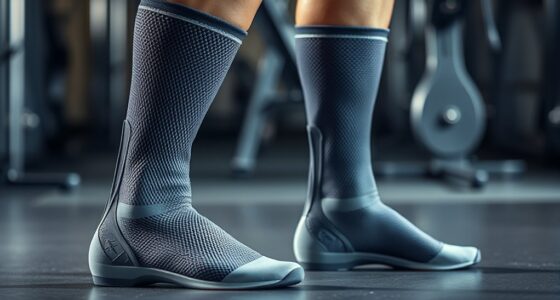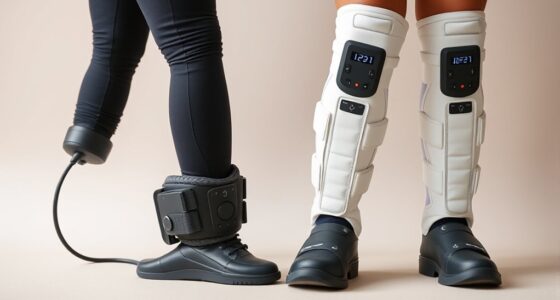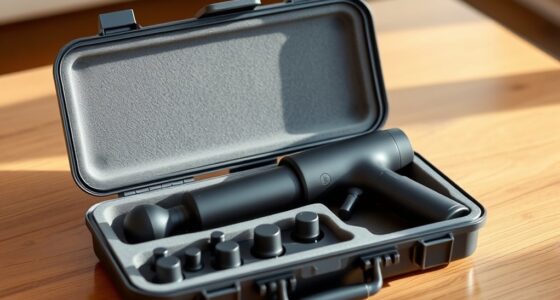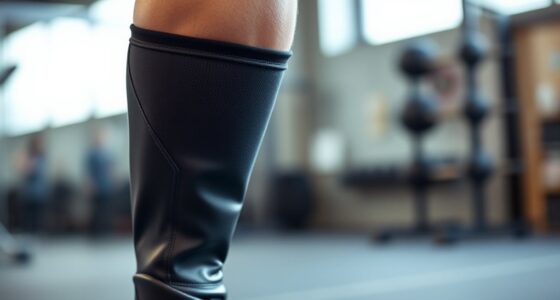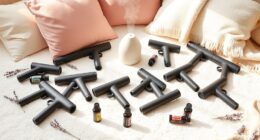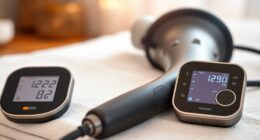Compression therapy improves circulation by gently applying pressure that helps blood move more efficiently from your muscles back to your heart. This enhances oxygen delivery, speeds up recovery, and reduces muscle fatigue and soreness. The graduated pressure of compression gear ensures ideal blood flow during activity, while supporting recovery afterward. If you want to discover how different types of gear and tips for best results can boost your performance, keep exploring more.
Key Takeaways
- Compression gear applies graduated pressure that boosts blood flow from muscles to the heart, reducing pooling and fatigue.
- Enhances oxygen and nutrient delivery to muscles, supporting endurance and faster recovery during and after activity.
- Promotes lymphatic drainage, decreasing swelling and inflammation to aid muscle repair and reduce soreness.
- Improves circulation efficiency, helping prevent micro-tears and injuries by supporting proper blood distribution.
- Reputable compression gear ensures optimal fit and pressure, maximizing circulation benefits for runners and athletes.
The Science Behind Compression and Blood Flow
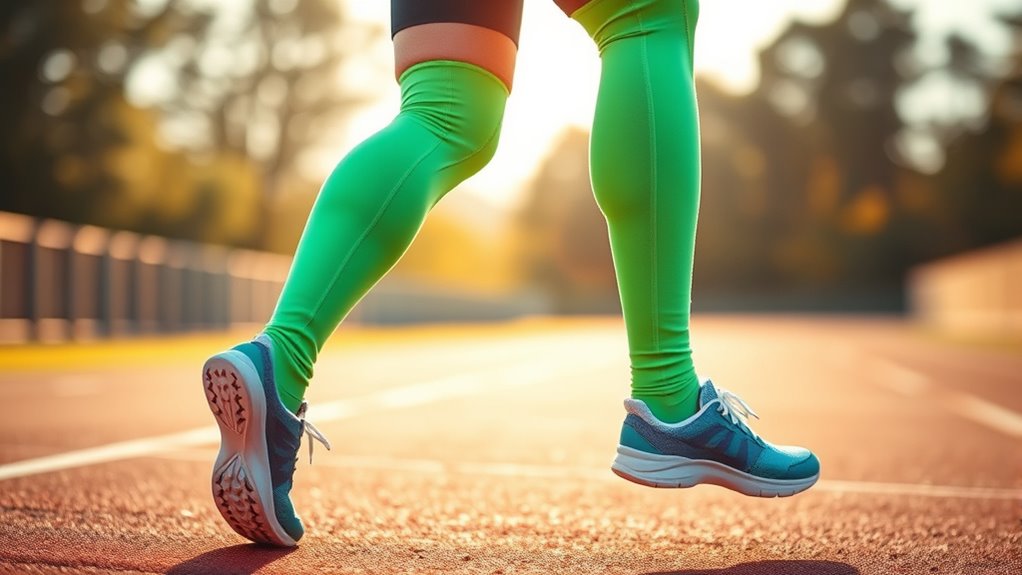
Understanding how compression works is essential to appreciating its benefits for runners. When you wear compression gear, it applies gentle pressure that influences blood vessel dynamics, helping to optimize blood flow. This pressure encourages blood to move more efficiently from your muscles back to your heart, reducing stagnation and pooling. As a result, your circulatory system works more effectively, supporting improved oxygen delivery to muscle tissues. Better oxygen delivery enhances your muscles’ endurance and speeds up recovery after runs. Additionally, compression helps prevent blood from pooling in your extremities, which can cause fatigue and soreness. By promoting steady blood flow, compression gear helps you stay energized and recover faster, making it a valuable tool for runners aiming to improve performance and overall circulation.
How Graduated Pressure Enhances Circulation
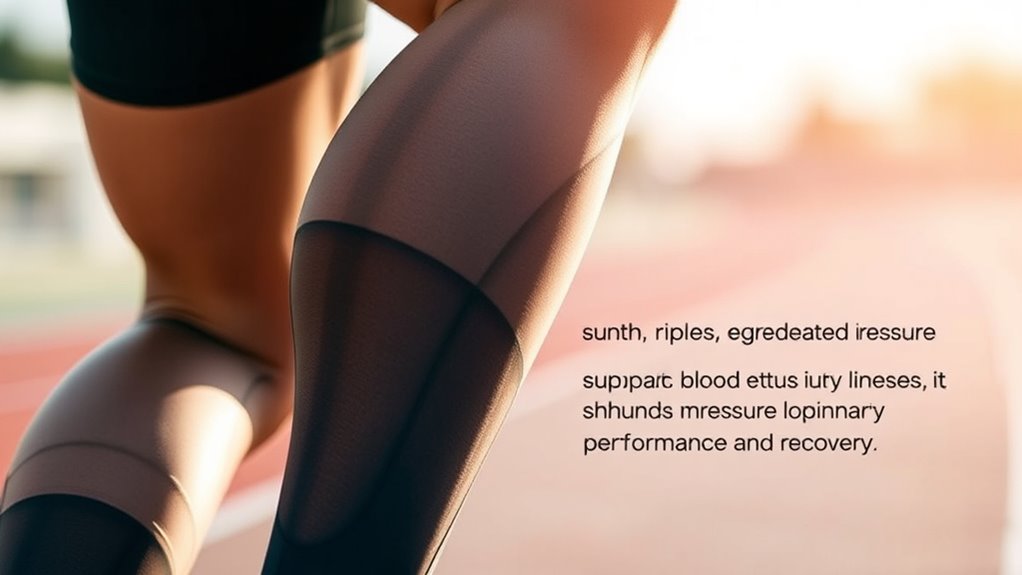
Graduated compression applies the right amount of pressure where your veins are largest, helping blood flow more efficiently back to your heart. This improved circulation reduces muscle swelling and speeds up recovery after your run. As a result, you’ll feel less soreness and more ready for your next workout. Additionally, selecting a name that reflects the dog’s personality can enhance your bond and make your pet feel truly special.
Improved Blood Flow
When you wear compression sleeves or socks with graduated pressure, it actively promotes better blood flow throughout your legs. This enhanced circulation helps deliver oxygen and nutrients more efficiently to your muscles, supporting quicker recovery and sustained performance. Many athletes report improved endurance and reduced fatigue with consistent use, citing positive athlete testimonials. The compression durability ensures your gear maintains consistent pressure over time, maximizing circulation benefits. Additionally, understanding Bitcoin IRA options can provide financial flexibility for athletes seeking alternative investment strategies.
Reduced Muscle Swelling
Wearing compression sleeves or socks with graduated pressure not only improves blood flow but also plays a key role in reducing muscle swelling after your runs. When you use compression, it helps facilitate lymphatic drainage and enhances circulation, which speeds up muscle recovery. This swelling reduction minimizes discomfort and tightness, allowing you to recover faster and prepare for your next workout. The graduated pressure design ensures that blood is efficiently pushed back toward your heart, decreasing fluid buildup in your muscles. By controlling swelling, compression therapy supports optimal muscle function and reduces the risk of injury caused by prolonged inflammation. Overall, incorporating compression into your post-run routine promotes quicker muscle recovery and keeps swelling in check, helping you stay active and ready for your next challenge.
Benefits of Improved Circulation During Exercise
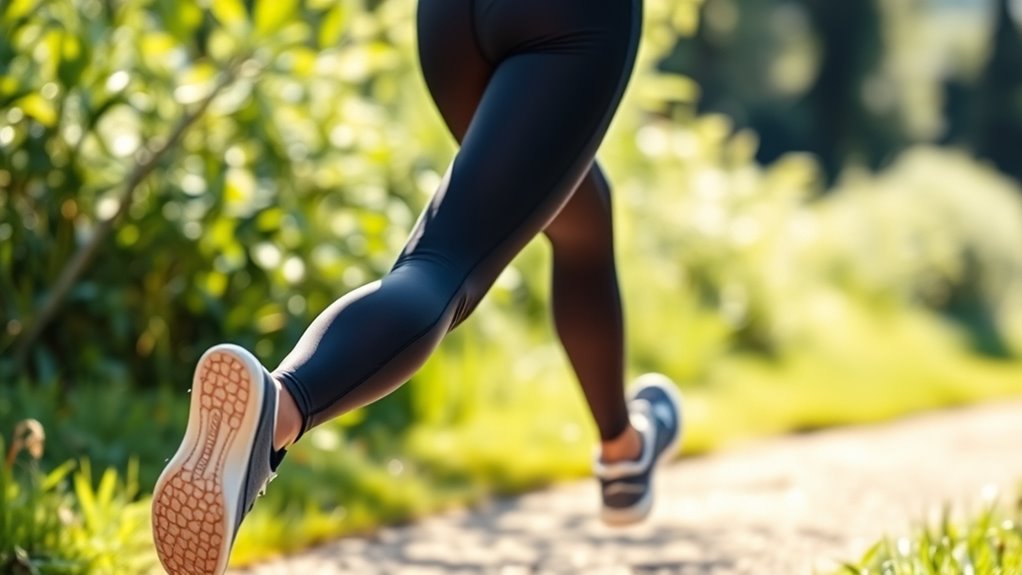
Enhanced circulation during exercise guarantees your muscles receive more oxygen and nutrients, helping you perform better and recover faster. When blood flow improves, your body more effectively delivers hydration, preventing dehydration that can impair performance. This also supports nutrition optimization by ensuring essential nutrients reach your muscles quickly, boosting endurance and strength. Better circulation reduces the risk of cramping and muscle fatigue, allowing you to maintain a consistent pace. You’ll find it easier to stay focused and motivated throughout your workout. Plus, improved blood flow helps regulate body temperature, keeping you comfortable. Incorporating mindset techniques such as visualization and positive affirmations can further enhance the effectiveness of circulation improvements. By enhancing circulation, compression therapy helps you maximize training benefits, sustain energy levels, and stay injury-free, so you can push your limits with confidence.
Recovery and Reduced Muscle Fatigue Through Compression
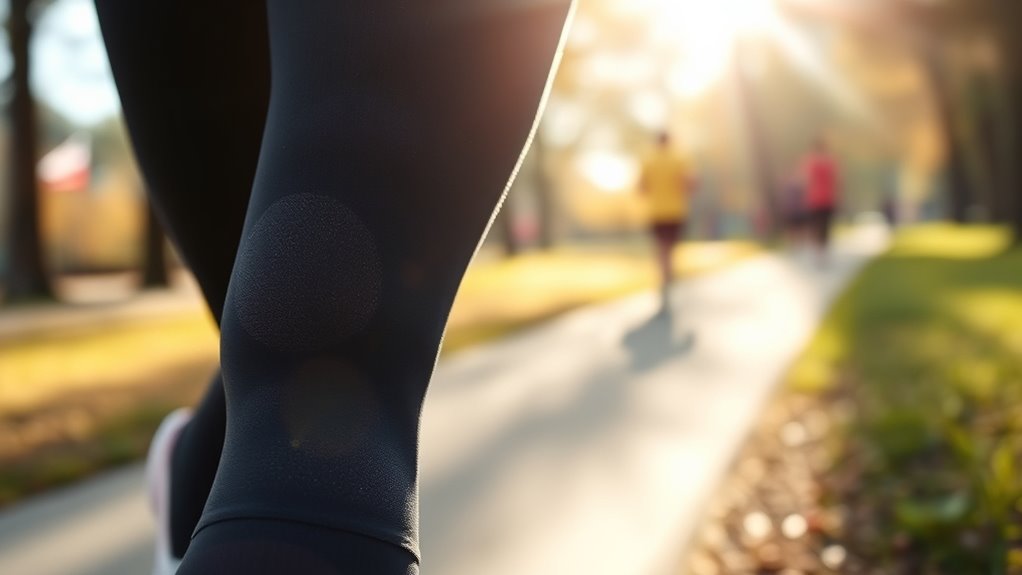
By providing gentle, consistent pressure, compression therapy helps speed up muscle recovery and reduces fatigue after intense exercise. This support enhances circulation, delivering oxygen and nutrients to tired muscles more efficiently. As a result, you experience less soreness and quicker return to peak performance. Compression gear offers targeted muscle support, minimizing micro-tears and aiding injury prevention. Imagine this visual:
| Muscle Support | Injury Prevention |
|---|---|
| Reduces swelling | Prevents strains and tears |
| Enhances nutrient flow | Lowers risk of overuse injuries |
| Promotes faster recovery | Supports overall muscle health |
This combination keeps your muscles supported, helping you recover faster and stay injury-free, so you can train harder and more consistently. Improving circulation can also help prevent issues like dizziness, which can interfere with your training routines.
Types of Compression Gear and Their Effectiveness
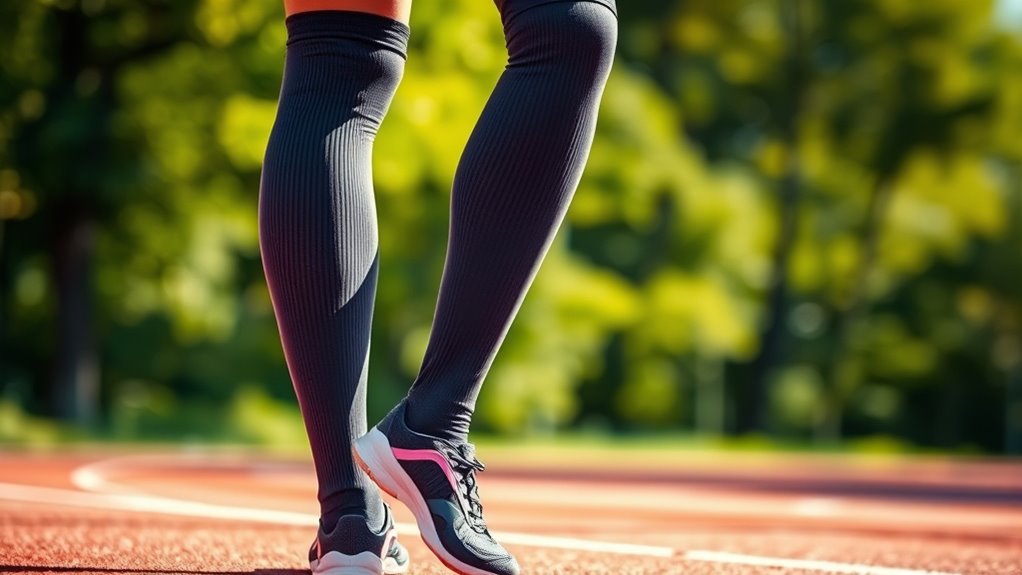
Choosing the right compression gear can substantially impact your recovery and performance. There are various types, including sleeves, socks, tights, and calves, each designed to target different areas. When exploring options, consider fashion trends, as stylish designs can boost confidence during workouts. Effectiveness depends on compression levels and fit; high-quality gear provides better circulation benefits. Brand comparisons reveal that reputable brands like 2XU, CEP, and Skins offer reliable compression, but prices vary. Some gear emphasizes durability and material quality, while others focus on sleek aesthetics. Ultimately, selecting gear that fits well and matches your activity level guarantees you maximize circulation benefits and enhance your athletic performance. Remember, the best compression gear is the one that works for your specific needs and style preferences. Incorporating evidence‑based practices ensures you make informed choices that support your health and fitness goals.
Tips for Incorporating Compression Therapy Into Training Routines
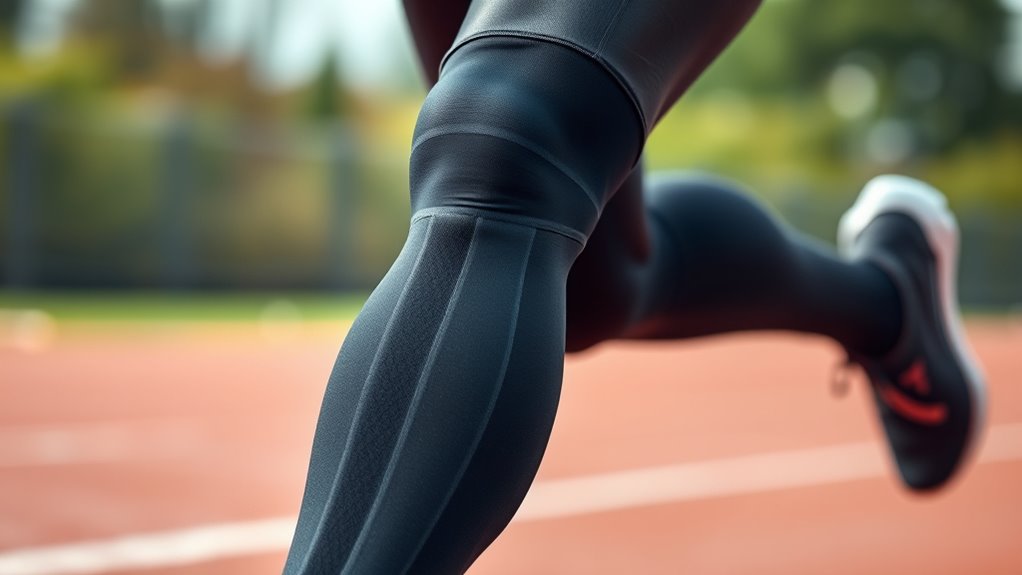
Incorporating compression therapy effectively into your training routine starts with understanding how to time its use for maximum benefit. Use it post-run to enhance athletic recovery, helping to reduce soreness and speed up muscle repair. Wearing compression gear during and after workouts can also support injury prevention by improving circulation and decreasing muscle fatigue. For best results, apply compression therapy consistently, especially during intense training phases or when increasing mileage. You might also consider pre-workout compression to prepare muscles, but prioritize recovery periods for injury prevention. Always choose the right compression level and fit to ensure comfort and effectiveness. Additionally, understanding how Gold IRA investments work can be a useful strategy for diversifying your financial portfolio and preparing for long-term financial stability. By strategically integrating compression therapy, you’ll optimize recovery, lessen injury risks, and keep your training on track.
Frequently Asked Questions
How Long Should I Wear Compression Gear During Workouts?
For ideal timing, you should wear compression gear during your workouts, typically 1-2 hours before and after exercise. Duration guidelines suggest wearing it during your entire workout to support circulation and recovery. If you’re engaging in intense or long sessions, extending wear time can be beneficial. Listen to your body, and if you experience discomfort, adjust accordingly. Consistent use enhances circulation and helps reduce muscle fatigue.
Can Compression Therapy Prevent Injuries in Athletes?
Did you know athletes using compression therapy report a 25% reduction in injury risk? Compression therapy can help prevent injuries by enhancing muscle recovery and reducing muscle soreness, which keeps you in better condition and less prone to strains or tears. By improving circulation, it supports faster healing and reduces inflammation, making it a smart addition to your injury prevention routine. Stay proactive and protect your performance with compression therapy.
Is Compression Therapy Effective for All Types of Sports?
Compression therapy can be effective across many sports, but it depends on your needs and the sport you play. You might find it enhances muscle recovery and reduces soreness, making it a valuable part of your sports equipment. While it benefits runners and athletes involved in high-impact sports, its effectiveness varies for different activities. Always consider your sport’s demands and consult with a professional to determine if compression therapy suits your routine.
Are There Any Risks or Side Effects From Using Compression Gear?
When using compression gear, you should be aware of potential risks like allergic reactions or skin irritation. Some people may develop redness, itching, or discomfort from materials or tightness. To minimize these issues, choose high-quality, breathable fabrics and make sure of proper fit. If you notice persistent irritation or allergic symptoms, it’s best to stop using the gear and consult a healthcare professional. Your comfort and skin health matter most.
How Does Compression Therapy Compare to Other Circulation-Enhancing Methods?
They say, “Don’t put all your eggs in one basket,” and that’s true for circulation methods. Compression therapy offers targeted compression benefits, improving blood flow efficiently. Compared to therapy alternatives like elevation or medication, compression provides active support during activity, often with fewer side effects. It’s a practical, non-invasive option, especially for runners and athletes seeking quick recovery and enhanced circulation, making it a smart choice among various methods.
Conclusion
So, next time you lace up, remember that those snug compression sleeves aren’t just about style—they actually boost circulation, helping you go farther and recover faster. Ironically, the very gear that looks like a fashion statement might be your secret weapon for supreme performance. Who knew that squeezing your legs could be the key to revealing your best run yet? Embrace compression, and watch how cleverly it works behind the scenes while you focus on the finish line.
